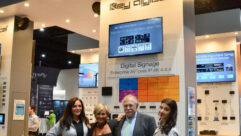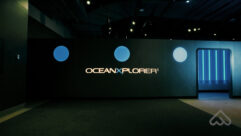A Work In Progress
Mar 1, 2001 12:00 PM,
Eddie Ciletti
TWO EVENTS OCCURRED AROUND 1960, WHEN I WAS FIVE, THAT arousedmy curiosity enough to inspire me for life. One was seeing myfavorite cartoons on a color TV for the first time. The other waseven more inspiring: My kindergarten class took a trip to FelsPlanetarium at Philadelphia’s Franklin Institute. Both of theseevents had a long-term impact on my life, played out as adolescentdistractions and, later, career experimentation. Planetariums (andtelevisions) have improved so much since I was five that they arenow almost unrecognizable as the same things. Today, I have found acalling and a challenge as a professional. In this industry, it isour turn to creatively apply new technology that will inspire thenext generation of techno-enthusiasts and scientists.
Nowhere are strides in technology more apparent than at theAmerican Museum of Natural History in New York. The recently addedFrederick Phineas and Sandra Priest Rose Center for Earth and Spacedid far more than just increase the square footage of the AMNH by atotal of 333,500 square feet (the equivalent of a major museum inits own right).
Aram Friedman is currently the director of engineering at theRose Center. His video career spans the last 20 years, an excitingtime for digital video and computer graphics. A recurring theme forFriedman is the application of new digital technology to an oldanalog process. As the technology matures, interface solutions areinvented and adapted. The process requires incredible amounts ofresearch. There are few experts, and the ink on whateverdocumentation exists isn’t dry. The sidebar, How Fast is Fast?, isa brief overview of the various flavors of video that we havetoday.
Eddie Ciletti: How did you become part of the Rose Centerproject?
Aram Friedman: I had just finished designing an automationsystem for Nice Shoes. (The job was a great way for me todecompress after working on the MSNBC graphics facility.) DennisDavidson (of AMNH) had seen flight simulation technology that, inhis vision, could hopefully be applied to a planetarium star showin a way that allowed more versatility than a traditional starprojector. The staff wrote a request for proposal. Potentialvendors responded with thick books of documentation that no one atthe museum had the skills to interpret. Dennis called me totranslate. It took eight days!
Who are your people?
The Rose Center engineering staff consists of five videoengineers, five Unix administrators and the senior engineers: BenjiBernhardt, Josh Minges and me. Anthony Braun is our staff producerand has been a long-term associate for our engineering projects. Wealso maintain a stable of freelance and part time engineering tocover the 24/7 operation.
Benji and you recently went to an electronic cinema conferenceheld by the National Institute of Standards and Technology. Whatdid you learn there?
We wanted to calibrate our understanding of the e-cinematechnology. Mostly, we learned that e-cinema will not fly unless itcan be as good as film, if not better. And, at the moment, movietheaters are not doing so well financially.
Who else do you work with?
Smokey Forester is the head of a production unit called ScienceBulletins. He and his crew specialize in creating content for themuseum the Hall of Planet Earth, the Astro Bulletins Wall and BioBulletins, in the Hall of Biodiversity. Basically, they wereshooting NTSC that, after editing, would be heavily compressed so aserver could deliver it. Together, we investigated HDtechnology.
What were the challenges in the beginning?
As I read through the documentation, I was inspired anddetermined to become part of the project. The challenge was to tryto equalize all of the doable options ranging in projected costfrom $2 million to $10 million to help them make a decision. Atthat time, no turnkey system (or systems integrator) existed. Isuggested that they tackle the project in-house by hiring supportspecialists for each technological facet. They agreed and westarted. It has been an incredible undertaking, and we’re notfinished yet!
This was just to realize the Digital Dome the Planetarium?
Designing an exhibition hall that will be capable of growingrequired us to consider not only what is possible at the moment butalso what will be possible. Aram Friedman
Initially, yes. It was the first time museum personnel had dailyaccess to an in-house engineering staff. They started asking us todo other things, a natural progression that led to our involvementbeyond the planetarium.
What are some of the costs involved?
A public exhibition space has its own requirements, not theleast of which is survival for a minimum of 30 years (hopefully, atleast 50), so it’s no surprise that the structure alone can costbetween $10 million and $20 million. Designing an exhibition hallthat will be capable of growing with changes in science andtechnology required us to consider not only what was possible atthe moment and remember we started this almost three years ago butalso what will be possible as technology matures.
How did you choose the equipment?
We contacted Fujitsu, Panasonic, Pioneer and Sony; and allprovided us with their 42-inch plasma displays. It was a tall orderbecause the flat-screen monitors were in such demand that we didn’thave much time to test them. Before the evaluation could begin, wehad to rent an HD camera and crew to record beauty shots around thecity. We shot using 1080i, the only option at that time.
Understand that a plasma display is not capable of displayingall of HD’s pixels. We learned that a good translation from 1080ito the native plasma format is key to appreciating and takingmaximum advantage of the capabilities of the display. We chose Sonyfor its flexible interface and support, but we also have a 50-inchPioneer display that has more pixels and is by far our premierscreen for special events. I’ve also seen a 60-inch Panasonic thatlooks equally gorgeous. (All screen dimensions are diagonal basedon a 16:9 aspect ratio.)
How is the reliability, and what problems have you had?
The 28 screens in the facility have been very reliable. We’velost a few a row or a column would fail all within the warrantyperiod. Occasionally, rough transit causes an out-of-the-boxfailure. Since these are gas-discharge displays, we anticipate atime when they will get tired, but that hasn’t happened yet.
What about the projectors, any preferences?
I can’t endorse any one projector because there are many modelsand many applications. We use Barco for our special venues; theyare modified for our purposes. I’ve seen a scanning laser projectorthat is beautiful and am hoping to bring it into the country.
Ultimately, you had to decide on a camera.
At the time we were looking at cameras, there were two options.Sony’s camera had a built-in tape machine. Panasonic made aseparate recorder for its camera. Both cameras looked great, butobviously the Sony was more convenient for documentary-style work.It also locked us into 1080i.
At first, we thought we had to catch up with the industry, butwe ended up ahead in the sense that the various screens became ouraudience, hungry for content. In order to create that content, itwas first necessary to build an HD editing and production facility,then decide on a server technology.
What was available?
Sierra Design Labs had a D-1 hard disk server. We discoveredthat Sony’s 7:1 compression technology was available as astand-alone encode/decode device. The Sierra is then connected toTelecast [www.telecast-fiber.com] fiber-optic transmissionequipment feeding thousands of feet of fiber.
Where are these screens and how do you feed them?
Plasma displays are all over the building, at the entrance toevery hall. The input options are NTSC, S-video, RGB, YUV andY-Pb-Pr, which is component with tri-level sync. (In tri-levelsync, the sync goes negative, then zero, then positive, then zeroagain.) We transmit HD serial digital over single-mode fiber,decoded using a D/A at each screen. D/A converters were expensiveat first. Then, AJA [www.aja.com] came out with a converter thesize of a cigarette pack for $2,000.
Now that all of the systems are installed, what is your primaryresponsibility?
The most important job is keeping the SKY theater (a.k.a. thePlanetarium or Digital Dome) working. Next is providing support forall of the production processes. Third is developing new technologyand new venues for the museum; we are a laboratory, of sorts.
How have things evolved since you started?
When we started, the available test and reference equipment wasminimal compared to traditional video. We couldn’t justify the$20,000 to $40,000 price tag for HD broadcast monitors. This is aclosed system. We shoot component digital so the image is locked(unlike NTSC). Color correction is not necessary, and theproductions will be viewed only on known monitors. Experience isteaching us what constitutes a good picture.
As for test equipment, Tektronix was traditionally my firstchoice, but their $30,000 scope didn’t do what we wanted.Surprisingly, Leader made a scope for $15,000 that met most of ourrequirements.
What reference material was available?
I read all that I could get my hands on from SMPTE and theAdvanced Television Systems Committee of the FCC. I also consultedthe very few people around the city who had HD experience. ChuckRoback, chief engineer at Tape House, and Dave Satin at SMA videohave the only two facilities with the Philips Spirit HD telecine(film-to-HD) converter.
How did you prepare for the Dome?
Diving into an emerging technology such as this, the firstversion of interface is analog, the second version is paralleldigital and the third version is serial digital.
We experimented by building a conference room using a $15,000Barco 808, 8-inch analog tube projector. Unlike plasma, the Barcohas HD resolution. This became our lab, a $75,000 prototype. Ourchoice of resolution for the dome was 1,280 by 1,024 (5 by 4, or anaspect ratio of 1.25:1), 60-frame progressive.
Already this was a higher resolution and frame rate than HDsupported; and the ONYX is capable of even more resolution,including a 72Hz frame rate. The additional power is for real-time3-D imaging, the type that requires two signals (left eye, righteye) to be output simultaneously for viewing via crystal glasses.We don’t do this (yet), but it serves as headroom.
On top of this, we had every kind of video source (RGB from PCs,Macs, the SGI Onyx and SGI 02 workstations), plus the usual analogformats (NTSC, S-video) from ABC and NASA’s satellite feeds.
A patching nightmare!
Indeed! The search to integrate all the various flavors led toan industry that I knew little about A/V. I also discovered an 8?8RGB analog routing switcher by Extron with 400MHz bandwidth percolor channel. We also use a similar product from AutoPatch.
Diving into an emerging technology such as this, the firstversion of interface is analog, the second is parallel digital andthe version is serial digital. In the case of the Dome, where thecomputer is located far away from the projectors, the analog 13W3outputs of the 7-Pipe ONYX II super computer (183MHz bandwidth)feed a super-high bandwidth Lightwave routing switcher which thenfeeds a Lightwave fiber transmitter/receiver. [lw.pennnet.com]
What are the Dome’s specs?
The dome is 21 meters (68 feet) across with seven projectorshidden in the wall at the horizon line. Five of the projectors are72 apart, illuminating the panorama. Two more projectorscriss-cross each other to illuminate the cap. We are also using anewer version of the Zeiss star projector. Projecting to a curvedsurface has its challenges, but it is also capable of generating3-D effects without special glasses, equipment or sourcematerial.
What sort of challenges?
Projection to a dome is a unique situation. Our Barco 812projector uses three 12-inch CRTs projecting 68 feet. It is not amatter of how bright, because projecting to a curved surfaceresults in a phenomenon known as cross-reflective contamination.Too much light will bounce and scatter, reducing contrast. The domeis light-tight like a camera, and we are counting on people havingnight vision.
A CRT projector can achieve true black because it is possible toturn the guns off, unlike LCD or DLT projectors, where theback-light is always on and the screen can not block all of thelight. A CRT has better contrast than solid-state chipprojectors.
What is shown on the dome?
Our in-house computer graphics department has created animmersive environment for the Dome, simulating the Milky Waygalaxy. A movie is stored on 14 Ciprico RAID drives. The data movesthrough the Onyx, which can render images in real time, then out tothe projectors. When this hardware choice was made, there was noother device capable of real-time playback of that much data. Weare about to put custom digital data recorders online to replacethe Ciprico drives.
How does the curved surface affect adjusting convergence onprojectors?
Ah! The CRT has a rubbery raster, so the convergence ismucked-up to compensate for the compound-curved surface, (both ahorizontal and vertical curve). Using a test grid, everything looksperfectly aligned. It creates an illusion of 3-D that I can notdescribe; you have to come see it.
I’d love to. Do you have any closing comments?
Considering what’s happened since I started in this business thetransition from 2-inch quad to 1-inch, analog to digital, thenlinear to non-linear editing there seem to be several recurringthemes. Twenty years ago, cameras were $100,000, and I watched astechnologies improved while the size shrunk and the price decreasedto $10,000. Now, HD cameras are $100,000 and the gear to do theprocessing and recording is equally expensive. As an engineer, thisis good for me, but it won’t last.
Whenever a change in technology occurs, the weak companies goout of business. The engineers make a good living for a while, andone group consistently never takes a hit: the contentproviders.
Oh yeah and you can’t make assumptions.
What do you mean?
When ABC chose the 720P format for broadcast, we wondered whybecause there’s less picture resolution but more frames (the latteris better for motion). Then, I coincidentally bought an iMac, andit came with a DVD drive and A Bug’s Life. I was shocked. Even withall of the compression, viewing the DVD on a high-resprogressive-scan computer monitor is amazing.
When we started, there was no 720P. The manufacturers based the1080i spec on the maximum capability of the recorders. But, whenthe 1080i signal is down-converted for use on a plasma screen, itis dumped into a buffer and essentially becomes a progressive scan.Solid-state displays are not scanned. Once all the information isin the buffer, the display reads it all at once.
We always worked with tube projectors and tube monitors. At onepoint we compared an HD LCD projector against our HD tubeprojector. The LCD looked fabulous, but the tube showed all of thetypical analog artifacts like ringing, plus the effects frominterlacing. So, I learned not to make assumptions or be too rigidin my thinking.
Thank you for your time, Aram. I look forward to talking again.Maybe when the Science Museum of Minnesota sees this article you’llbe coming here, and I can be your assistant!
It was indeed a pleasure. There is so much more to talk about;we really haven’t scratched the surface. This conversation couldcontinue for weeks. You know, if you lived here you’d have ajob.
Eddie Ciletti spent 19 years chasing hums and buzzes in New YorkCity. He now chases his son Luca in the Twin Cities area. Drop bywww.tangible-technology.comfor a virtual visit.
How Fast is Fast?
ANALOG AUDIO HAS A BANDWIDTH OF 20 KHZ. Digital audio requires 6mHz of bandwidth just like analog video that’s 300 times as much!The data rate of an audio CD is 1.4 mega-bits per second. Dividingby 8 bits turns that into 175 kilo-bytes per second. Basically,bandwidth is to analog as data rate is to digital. You will seethat the bandwidth required for digital HD is astounding, puttingheavy demands on cabling, connectors, patch bays and routingswitchers (Belden 1505A co-ax, King 2025-51-9 connectors andTrompeter 1.5 gig patchbays, for example).
Imagine the jump from analog video to digital video. At 143 MB/s(4fsc NTSC) the data stream generated by 640?480 (displayed) pixelsis a trickle compared to the deluge of pixels HD can generate.(Pixels are the equivalent of a horizontal scan line in analog.)While there are many different types of HD, the serial digital(RS292) version requires approximately 1.5 GB/s (750 MHz). Bycontrast, analog HDTV’s bandwidth requirements range fromapproximately 93.3 MHz (per RGB channel) to 186 MHz (based on anSGI Onyx II generating a 1,600?1,024 image at a 76Hz framerate).
NOTE 1. Some of the above figures came from Michael Robin’sBroadcast Engineering article, Routing for Video. Michael isco-author of Digital Television Fundamentals, published byMcGraw-Hill. Send questions and comments to [email protected].
NOTE 2. All of the above specs are for non-compressed,device-to-device transmission. For specific information, visit:
www.atsc.org The FCC’sAdvanced Television Systems Committee is in charge of broadcaststandards. ATSC Documents A/53 and A/54 are free andinformative.
www.smpte.org The Societyof Motion Picture and Television Engineers’ committees set thestandards for digital cinema, as well as TV and motion pictures.Documents are accessible for a small fee.










